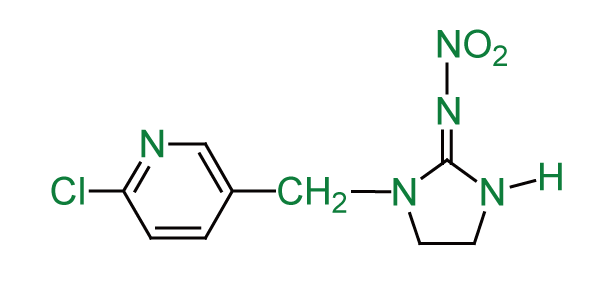- Abamectin
- Acetamiprid
- Alpha-cypermethrin
- Amitraz
- Azamethiphos
- Bifenthrin
- Bacillus thuringiensis
- Carbosulfan
- Chlorfenapyr
- Chlorfluazuron
- Chlorpyfifos
- Clothianidin
- Cypermethrin
- Cyphenothrin
- Clofentezine
- Cyromazine
- Deltamethrin
- Diafenthiuron
- Diazinon
- Diflubenzuron
- Emamectin Benzoate
- Empenthrin
- Fipronil
- Flufenoxuron
- Fenazaquin
- Hexythiazox
- Hydramethylnon
- Imidacloprid
- Indoxacarb
- Lambda-cyhalothrin
- Lufenuron
- Malathion
- Methomyl
- Nitenpyram
- Novaluron
- Permethrin
- Propargite
- Profenofos
- Pymetrozine
- Pyriproxyfen
- Sulfluramid
- Teflubenzuron
- Tetramethrin
- Thiamethoxam
- Thiodicarb
- Trichlorfon
- Triflumuron
Imidacloprid

Other Name:1-[(6-chloro-3-pyridinyl)methyl]-N-nitro-2-imidazolidinimine; Imidaclopride
CAS Number: [ 138261-41-3]
Molecular Formula: C9H10ClN5O2
Imidacloprid is a systemic insecticide which acts as an insect neurotoxin and belongs to a class of chemicals called the neonicotinoids insecticides which are considered safe when they were introduced because their toxicity to mammals is far lower than it is to insects. These compounds act on the central nervous system of insects. Imidacloprid is not only the leading neonicotinoid, but it is the world’s most widely used insecticide.
In recent years, the declining population of honeybees and other beneficial insects has been attributed to the widespread use of imidacloprid.
APPLICATIONS
Biochemistry  Steroid demethylation (ergosterol biosynthesis) inhibitor.
Steroid demethylation (ergosterol biosynthesis) inhibitor.
Mode of action
Systemic fungicide, with protective and curative action.
Uses
Control of a wide range of fungal diseases on fruit, vegetables, and ornamentals, e.g. powdery mildews on cucurbits and ornamentals; powdery mildew on roses; storage diseases (particularly Penicillium, Gloeosporium, Phomopsis, Phoma spp., etc.) of citrus fruit, pome fruit, bananas, and seed potatoes. Also used as a seed dressing, for control of diseases (particularly Fusarium and Helminthosporium spp.) of cereals. It is particularly active against benzimidazole-resistant strains of plant-pathogenic fungi. Typical use rates are: for seed treatment 4-5 g/100 kg seed; for ornamentals and vegetables 5-30 g/hl; and for post-harvest treatment 2-4 g/t fruit.
Formulation types EC; SP;
Our Technical Material (TC) have the specification as per GB 28126-2011
| Items | Specification |
| Appearance | Slightly yellow to brown, crystalline powder |
| Content | 97% min. |
| Loss on drying | 0.5% max. |
| DMF Insoluble | 0.2% max. |
| pH range | 5.0-8.0 |
GHS complaint Safety Data Sheet (SDS) for commercial product of Imidacloprid is available uopn requested.
